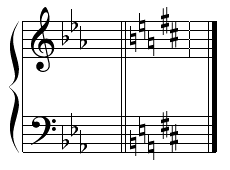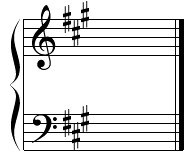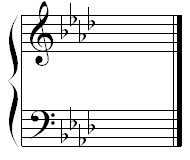What the ‘Keys’ Are All About
 Many music students struggle with key signatures, however, over time they eventually learn many of the keys and associated scales.
Many music students struggle with key signatures, however, over time they eventually learn many of the keys and associated scales.
At the workshop we promote an easy way to develop the change in keys and then how to remember the key names.
This helps to put the foundation in place so that when you run across a new key signature you are well ahead of the pack when dealing with your new song.
The steps to be taken are:
-
Begin with some basic definitions,
-
Review of the master staff and how keys are shown,
-
Show you how to create a simple method so that you can learn how to build the keys.
From this we will then go into ‘learning it’ mode and actually work through all the sharp and flat keys.
Starting Off – Definitions
Let’s get started. One of the first things we need to consider is what are the definitions. A quick review of things you should already know will help.
Note that there are many references to the keyboard. This is due to the visual use of the black and white keys that are one of the most recognized visual props when studying music.
You should know about note names and the symbols for sharps (#) and flat (b) notes.
As well you should understand how the sharp and flat symbols are used.
You should be familiar with the master staff and intervals.
You can review these music theory elements by clicking on the links or the navigation bar.
Key Names
The other thing you should be aware of is that note names are used to state the keys. These follow few items are an overview which will allow you get “into the keys”.
-
Keys with Sharps have a simple note name like G, D, or A for example.
-
The exception is for C sharp (C#), and F Sharp (F#); these are the first key signatures to use the black keys to define the signature.
-
For Flat key signatures – only the key of F does not start on the name of a flat key.
- Flat keys all start on the flat note such as Bb, Eb, or Db.
These are general naming characteristics to keep in mind as you learn about the keys. Review them from time to time as you progress through the learning steps.
Music Theory – Key Characteristics
-
Key changes use the Major Scale for base definitions.
-
Minor Scales are related to the Major Scale by a minor 3rd down.
-
Chords for each key signature are created from the major scale.
-
By adding a sharp to the key name it will increase the scale and chords by a half step ( Primarily used with minor keys, although this principle can be applied to major keys)
-
Adding a flat to the key name will decrease the scale and chords by a half step
-
To add another sharp or flat is done by going ‘up a fifth’ or ‘down a fourth’. This is also known as the circle of fifths. (Up a 5th – C to G, Down a fourth C to G)
- Alternately ‘down a fifth’ or ‘up a fourth’ will allow the formation of a flat key.
These are broad statements and are not necessarily true to academic teachings, however, they are ways to look at the key signatures that apply a practical application of how to quickly and easily learn key signatures.
Putting Sharps or Flats on the
Master Staff We use the master staff to show sharps or flats. The picture here shows how three sharps and four flats are shown on the master staff.
 |
 |
At this point only notice that the sharps and flats are similar in pattern on both of the staves and they actually occupy the same note names in both the treble (G) clef and the bass (F) clef.
In this case they are shown in order.
For the sharps the order is: F#, C#, and G# and flats it is Bb, Eb, Ab, and Db.
It’s hard to wait but the patterns you will see are going to be really helpful in working with key signatures.
Consider The Key Signature and Scale Workshop to get these two elements of music down cold fast!


